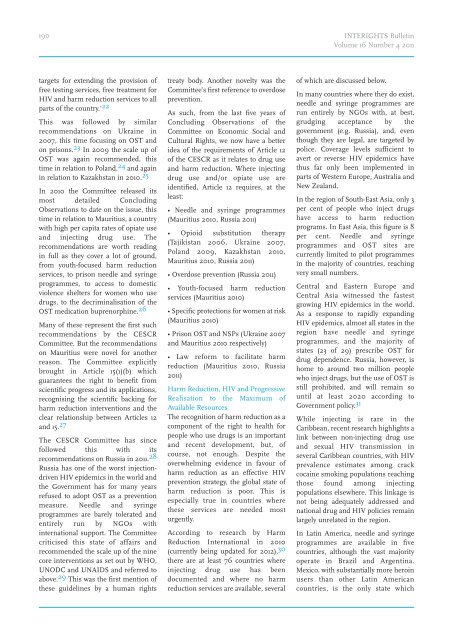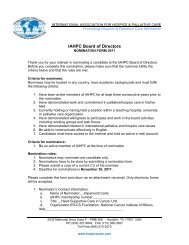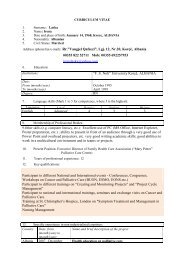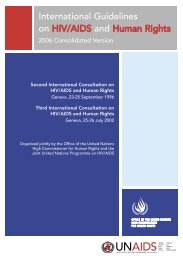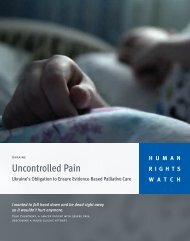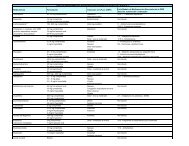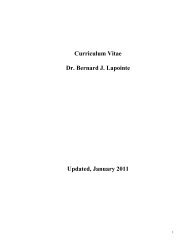INTERIGHTS Bulletin
INTERIGHTS Bulletin
INTERIGHTS Bulletin
You also want an ePaper? Increase the reach of your titles
YUMPU automatically turns print PDFs into web optimized ePapers that Google loves.
190<br />
<strong>INTERIGHTS</strong> <strong>Bulletin</strong><br />
Volume 16 Number 4 2011<br />
targets for extending the provision of<br />
free testing services, free treatment for<br />
HIV and harm reduction services to all<br />
parts of the country.’ 22<br />
This was followed by similar<br />
recommendations on Ukraine in<br />
2007, this time focusing on OST and<br />
on prisons. 23 In 2009 the scale up of<br />
OST was again recommended, this<br />
time in relation to Poland, 24 and again<br />
in relation to Kazakhstan in 2010. 25<br />
In 2010 the Committee released its<br />
most detailed Concluding<br />
Observations to date on the issue, this<br />
time in relation to Mauritius, a country<br />
with high per capita rates of opiate use<br />
and injecting drug use. The<br />
recommendations are worth reading<br />
in full as they cover a lot of ground,<br />
from youth-focused harm reduction<br />
services, to prison needle and syringe<br />
programmes, to access to domestic<br />
violence shelters for women who use<br />
drugs, to the decriminalisation of the<br />
OST medication buprenorphine. 26<br />
Many of these represent the first such<br />
recommendations by the CESCR<br />
Committee. But the recommendations<br />
on Mauritius were novel for another<br />
reason. The Committee explicitly<br />
brought in Article 15(1)(b) which<br />
guarantees the right to benefit from<br />
scientific progress and its applications,<br />
recognising the scientific backing for<br />
harm reduction interventions and the<br />
clear relationship between Articles 12<br />
and 15. 27<br />
The CESCR Committee has since<br />
followed this with its<br />
recommendations on Russia in 2011. 28<br />
Russia has one of the worst injectiondriven<br />
HIV epidemics in the world and<br />
the Government has for many years<br />
refused to adopt OST as a prevention<br />
measure. Needle and syringe<br />
programmes are barely tolerated and<br />
entirely run by NGOs with<br />
international support. The Committee<br />
criticised this state of affairs and<br />
recommended the scale up of the nine<br />
core interventions as set out by WHO,<br />
UNODC and UNAIDS and referred to<br />
above. 29 This was the first mention of<br />
these guidelines by a human rights<br />
treaty body. Another novelty was the<br />
Committee’s first reference to overdose<br />
prevention.<br />
As such, from the last five years of<br />
Concluding Observations of the<br />
Committee on Economic Social and<br />
Cultural Rights, we now have a better<br />
idea of the requirements of Article 12<br />
of the CESCR as it relates to drug use<br />
and harm reduction. Where injecting<br />
drug use and/or opiate use are<br />
identified, Article 12 requires, at the<br />
least:<br />
• Needle and syringe programmes<br />
(Mauritius 2010, Russia 2011)<br />
• Opioid substitution therapy<br />
(Tajikistan 2006, Ukraine 2007,<br />
Poland 2009, Kazakhstan 2010,<br />
Mauritius 2010, Russia 2011)<br />
• Overdose prevention (Russia 2011)<br />
• Youth-focused harm reduction<br />
services (Mauritius 2010)<br />
• Specific protections for women at risk<br />
(Mauritius 2010)<br />
• Prison OST and NSPs (Ukraine 2007<br />
and Mauritius 2010 respectively)<br />
• Law reform to facilitate harm<br />
reduction (Mauritius 2010, Russia<br />
2011)<br />
Harm Reduction, HIV and Progressive<br />
Realisation to the Maximum of<br />
Available Resources<br />
The recognition of harm reduction as a<br />
component of the right to health for<br />
people who use drugs is an important<br />
and recent development, but, of<br />
course, not enough. Despite the<br />
overwhelming evidence in favour of<br />
harm reduction as an effective HIV<br />
prevention strategy, the global state of<br />
harm reduction is poor. This is<br />
especially true in countries where<br />
these services are needed most<br />
urgently.<br />
According to research by Harm<br />
Reduction International in 2010<br />
(currently being updated for 2012), 30<br />
there are at least 76 countries where<br />
injecting drug use has been<br />
documented and where no harm<br />
reduction services are available, several<br />
of which are discussed below.<br />
In many countries where they do exist,<br />
needle and syringe programmes are<br />
run entirely by NGOs with, at best,<br />
grudging acceptance by the<br />
government (e.g. Russia), and, even<br />
though they are legal, are targeted by<br />
police. Coverage levels sufficient to<br />
avert or reverse HIV epidemics have<br />
thus far only been implemented in<br />
parts of Western Europe, Australia and<br />
New Zealand.<br />
In the region of South-East Asia, only 3<br />
per cent of people who inject drugs<br />
have access to harm reduction<br />
programs. In East Asia, this figure is 8<br />
per cent. Needle and syringe<br />
programmes and OST sites are<br />
currently limited to pilot programmes<br />
in the majority of countries, reaching<br />
very small numbers.<br />
Central and Eastern Europe and<br />
Central Asia witnessed the fastest<br />
growing HIV epidemics in the world.<br />
As a response to rapidly expanding<br />
HIV epidemics, almost all states in the<br />
region have needle and syringe<br />
programmes, and the majority of<br />
states (23 of 29) prescribe OST for<br />
drug dependence. Russia, however, is<br />
home to around two million people<br />
who inject drugs, but the use of OST is<br />
still prohibited, and will remain so<br />
until at least 2020 according to<br />
Government policy. 31<br />
While injecting is rare in the<br />
Caribbean, recent research highlights a<br />
link between non-injecting drug use<br />
and sexual HIV transmission in<br />
several Caribbean countries, with HIV<br />
prevalence estimates among crack<br />
cocaine smoking populations reaching<br />
those found among injecting<br />
populations elsewhere. This linkage is<br />
not being adequately addressed and<br />
national drug and HIV policies remain<br />
largely unrelated in the region.<br />
In Latin America, needle and syringe<br />
programmes are available in five<br />
countries, although the vast majority<br />
operate in Brazil and Argentina.<br />
Mexico, with substantially more heroin<br />
users than other Latin American<br />
countries, is the only state which


